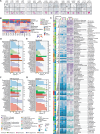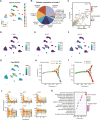Deciphering cholangiocarcinoma heterogeneity and specific progenitor cell niche of extrahepatic cholangiocarcinoma at single-cell resolution
- PMID: 40551145
- PMCID: PMC12186425
- DOI: 10.1186/s13045-025-01716-z
Deciphering cholangiocarcinoma heterogeneity and specific progenitor cell niche of extrahepatic cholangiocarcinoma at single-cell resolution
Abstract
Background: Cholangiocarcinoma (CCA) is a highly heterogeneous malignancy, primarily comprising intrahepatic (iCCA) and extrahepatic (eCCA) subtypes. Reconciling the variability between iCCAs and eCCAs in clinical trials remains a challenge, largely due to the inadequate understanding of their shared and subtype-specific cellular heterogeneity. We aim to address this issue using single-cell and spatially resolved transcriptomic approaches.
Methods: We performed comprehensive single-cell RNA sequencing (scRNA-seq) by profiling 109,071 single cells from 28 samples, including chronic biliary inflammatory conditions (n = 7) and CCAs from different anatomical sites (n = 21). Findings were validated using external multi-omics datasets, tissue microarray cohort, spatial RNA in situ sequencing, CCA patient-derived organoids (PDOs), and mouse models.
Results: iCCAs and eCCAs exhibited distinct tumor ecosystems, with notable differences in cellular composition, diversity, and abundance across various cell types. Non-malignant epithelial cells displayed divergent precancer hallmarks from different biliary sites, with inflammatory extrahepatic bile ducts exhibiting early hijacking of the gastrointestinal metaplastic process. We identified seven meta-programs within cancer cells, mapped into four major subtypes. This subtyping was validated using external CCA cohorts and PDO models, distinguishing patients based on clinical outcomes and drug vulnerabilities. Specifically, iCCAs were associated with a senescent program, while eCCAs were enriched in an IFN-responsive program linked to adverse clinical outcomes and increased drug resistance. We identified a basal-like LY6D+ cancer cell subpopulation specific to eCCAs, which displayed significant stemness, drug resistance, and IFN-responsive features. This subpopulation was closely associated with an interferon-stimulated gene 15 (ISG15)-enriched mesenchymal and immune microenvironment. Functional assays demonstrated that ISG15 stimulation significantly boosted stemness, basal-like features, and drug resistance in eCCA cells, highlighting its pivotal role in sustaining the LY6D+ progenitor niches.
Conclusion: We present a comprehensive single-cell landscape of CCAs, uncovering the molecular heterogeneity between iCCA and eCCA subtypes. Transcriptomic subtyping of CCA cancer cells offers implications for clinical stratification and functional precision oncology. We identify basal-like epithelial progenitors and characterize their associated ISG15-enriched microenvironment in eCCAs. These findings hold significant promise for the development of novel prognostic biomarkers, therapeutic targets, and treatment strategies for CCAs.
© 2025. The Author(s).
Conflict of interest statement
Declarations. Ethics approval and consent to participate: This study was approved by the Ethical Committee of Eastern Hepatobiliary Surgery Hospital (No. EHBHKY2018-1-001). Written informed consent was obtained from each patient involved in the CCA scRNA-seq cohort. Competing interests: The authors declare no competing interests.
Figures








References
-
- Qurashi M, Vithayathil M, Khan SA. Epidemiology of cholangiocarcinoma. Eur J Surg Oncol 2023:107064. - PubMed
-
- Lanzoni G, Cardinale V, Carpino G. The hepatic, biliary, and pancreatic network of stem/progenitor cell niches in humans: A new reference frame for disease and regeneration. Hepatology. 2016;64(1):277–86. - PubMed
MeSH terms
Grants and funding
LinkOut - more resources
Full Text Sources
Medical
Research Materials
Miscellaneous

